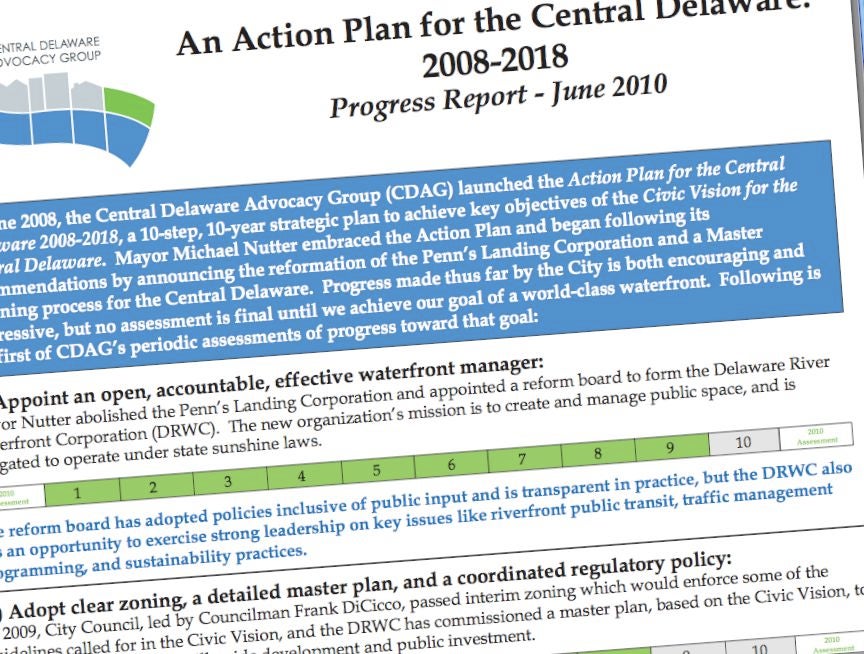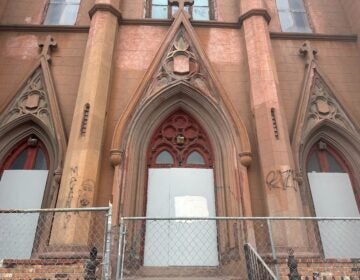CDAG issues waterfront progress report

The Central Delaware Advocacy Group has issued a progress report on Philadelphia’s efforts toward creating a world-class waterfront.
CDAG Chairman Steve Weixler said the report is not meant to remark on the progress of any one particular city agency or politician, but reflects on all of them – plus the advocacy community, neighborhood associations, developers and property owners. “We’re all in this together,” Weixler said.
High marks were given on the 1-to-10 scale for the public way the Delaware River Waterfront Corporation, which oversees the development and management of the city’s public spaces along the river, has worked on a new, long-range plan for the Central Delaware between Oregon and Allegheny Avenues.
The CDAG report also praised the work done to adopt legislation and zoning policies designed to guide the implementation of the Central Delaware Master Plan, which is still being drafted, and for the creation of new parks along the 7-mile stretch of waterfront. Kudos were given for the quick job in working toward bookend green spaces on the Race Street Pier and at the foot of Pier 53.
“There’s a great deal that’s been accomplished,” said CDAG member Joe Schiavo, who led the group through the process of drafting the progress report. “When you look at what the city did over the past 30 years in terms of waterfront development, this has been fantastic progress over the past two years,” he said. “And the groundwork has been laid for appropriate development going forward. There are genuine guidelines, and that we have never had previously.”
But CDAG, an organization of representatives from waterfront communities and organizations that was created to advocate for the goals Philadelphians set for their riverfront during more than a year of public meetings, gave lower marks in other areas.
Not enough has been done yet, the report says, to ensure a 100-foot green buffer between the rivers’ edge and development. While the interim zoning overlay calls for a 100-foot setback in most areas, it does not address the quality of that setback. There is a big difference between a natural area that would help restore environmental quality and pavement, noted Schiavo. Greenway support could be achieved through either the re-write of the zoning code or the master planning process, both of which are underway, the report states.
The lowest mark of all – a one – was given for the city’s effort at extending the street grid down to the waterfront. “The master plan process should focus on the key streets identified in the Action Plan (Tasker, Reed, Pier 70 Boulevard, Washington, Brown, Shackamaxon, Beach and Lehigh) as well as others that should be added to the city plan to integrate the riverfront with neighborhoods,” the report states. “City planners must stand up to development interests and extend the street grid to the river. The City has failed to call for the opening of Shackamaxon on the SugarHouse site as a real street for public access and as a control against further sprawl by the casino, and Reed Street on the Foxwoods site may suffer the same fate. ”
Weixler said more communication needs to happen with PennDOT to discuss new design ideas for the rebuilding of I-95 to make the riverfront as accessible as possible from the neighborhoods.
The 10 categories in which ratings were given reflect the 10 points of the Central Delaware Action Plan, a 10-year blueprint toward achieving the city’s riverfront goals that CDAG created in June 2008.
The assessments at the top of the list tend to be higher than those toward the bottom, and that’s no coincidence, Schiavo said. Some of the goals toward the bottom are very likely not to be completely realized for many more years, he said, so a 10 could not have been given.
“Hopefully, those lower assessment marks will simply draw focus to those points,” Schiavo said. “With other things accomplished, we can now focus on those points.”
Originally, CDAG was going to release a different document in November 2009, prior to the start of a meeting where the five finalists for the master plan team were announced. Word got out before that could happen, and, after receiving criticism on the timing and the method from Councilman Frank DiCicco’s office, the DRWC and city leaders, CDAG killed the release.
Back then, instead of a numeric rating scale, letter grades were issued and the document was called a report card.
In addition to the name-change and switch to a numeric scale, CDAG also added a preamble that explains the goal is to show progress toward goals, not to condemn performance – a goal Schiavo and Weixler said has not changed. CDAG also sent copies of the report to those in leadership positions before sharing it with PlanPhilly. A general media release is planned for Monday.
Neither DiCicco nor DRWC President Tom Corcoran could be reached for comment Friday. Deputy Mayor Alan Greenberger, who is also the head of city planning, remembered what it felt like in November.
“Here we were trying to do a public event last time, and it felt like (the planned release) was running contrary to things other groups urge us to do: Keep everyone informed, no surprises, don’t torpedo an event,” he said. Releasing the report card then would have been a distraction from the main event that night – an important milestone toward goals that CDAG shares, Greenberger said.
By contrast, the method this time was “A good way to handle it, and fair,” Greenberger said. He said he hadn’t had time to look at the report yet – he’ll do so this weekend – and so he wouldn’t comment on the assessment itself.
When asked what assessment he would give toward meeting the goals for the waterfront, Greenberger called the progress tremendous. “The Race Street Pier is moving ahead – construction is happening as we speak on the substructure of the pier and we’re waiting for final cost numbers … . We are also moving forward on a clean and green effort on the upland side of Pier 53 … work will start this summer and be done by fall.
“On the Master Plan there’s been great progress, and the public meetings have been very good. That’s pretty good progress.”
Weixler and Schiavo also said they like the current document and the way it was released much better now than they did then. Schiavo said any criticism about the aborted release should be directed at him. He said he was focused on getting the document, once finished, out into the public, and he’s just not very politics-minded.
Schiavo stressed that the criticism did not influence the meat of CDAG’s progress assessment, or result in a rosier picture. What did bump up the performance rating a bit was the passage of time, he said. DRWC in particular was moving so quickly on a number of goals that CDAG had to keep revising the document, Schiavo said.
CDAG intends to release progress reports periodically over the 10-year period for which the Action Plan establishes its goals.
Reach the reporter at kgates@planphilly.com.
WHYY is your source for fact-based, in-depth journalism and information. As a nonprofit organization, we rely on financial support from readers like you. Please give today.





